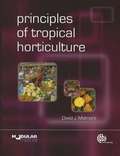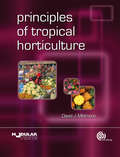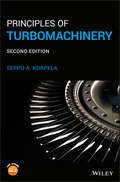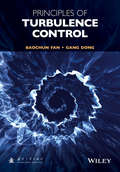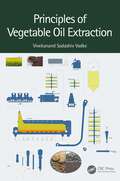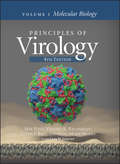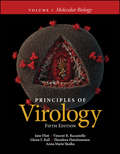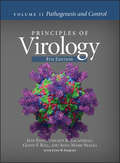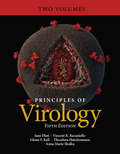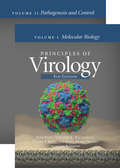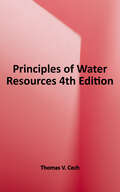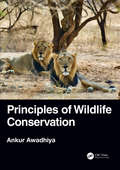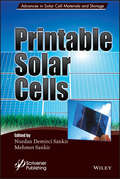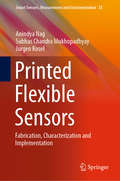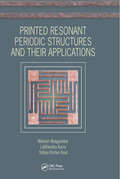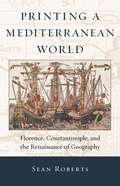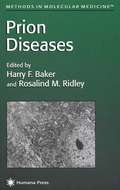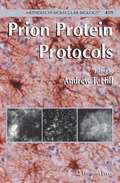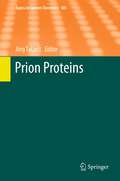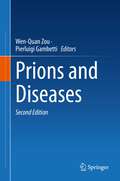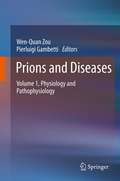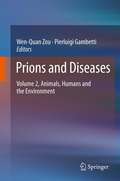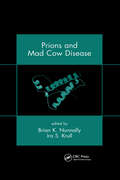- Table View
- List View
Principles of Tropical Horticulture
by David MidmorePrinciples of Tropical Horticulture leads the reader through a background of environmental influences and plant physiology to an understanding of production and post-harvest systems, environmental adaptation techniques and marketing strategies. Focusing on the principles behind production practices and their scientific basis, rather than detailed biological traits of each crop, this text outlines successes and failures in practices to date and sets out how the quantity and quality of horticultural produce can improve in the future. Case studies are frequently used and chapters cover the production of vegetables, fruit and ornamental crops, including temperate zone crops adapted to grow in the tropics. Read a chapter for free.
Principles of Tropical Horticulture (Animal And Veterinary Science Ser.)
by David MidmorePrinciples of Tropical Horticulture leads the reader through a background of environmental influences and plant physiology to an understanding of production and post-harvest systems, environmental adaptation techniques and marketing strategies. Focusing on the principles behind production practices and their scientific basis, rather than detailed biological traits of each crop, this text outlines successes and failures in practices to date and sets out how the quantity and quality of horticultural produce can improve in the future. Case studies are frequently used and chapters cover the production of vegetables, fruit and ornamental crops, including temperate zone crops adapted to grow in the tropics.
Principles of Turbomachinery
by Seppo A. KorpelaA newly updated and expanded edition that combines theory and applications of turbomachinery while covering several different types of turbomachinery In mechanical engineering, turbomachinery describes machines that transfer energy between a rotor and a fluid, including turbines, compressors, and pumps. Aiming for a unified treatment of the subject matter, with consistent notation and concepts, this new edition of a highly popular book provides all new information on turbomachinery, and includes 50% more exercises than the previous edition. It allows readers to easily move from a study of the most successful textbooks on thermodynamics and fluid dynamics to the subject of turbomachinery. The book also builds concepts systematically as progress is made through each chapter so that the user can progress at their own pace. Principles of Turbomachinery, 2nd Edition provides comprehensive coverage of everything readers need to know, including chapters on: thermodynamics, compressible flow, and principles of turbomachinery analysis. The book also looks at steam turbines, axial turbines, axial compressors, centrifugal compressors and pumps, radial inflow turbines, hydraulic turbines, hydraulic transmission of power, and wind turbines. New chapters on droplet laden flows of steam and oblique shocks help make this an incredibly current and well-rounded resource for students and practicing engineers. Includes 50% more exercises than the previous edition Uses MATLAB or GNU/OCTAVE for all the examples and exercises for which computer calculations are needed, including those for steam Allows for a smooth transition from the study of thermodynamics, fluid dynamics, and heat transfer to the subject of turbomachinery for students and professionals Organizes content so that more difficult material is left to the later sections of each chapter, allowing instructors to customize and tailor their courses for their students Principles of Turbomachinery is an excellent book for students and professionals in mechanical, chemical, and aeronautical engineering.
Principles of Turbulence Control
by Baochun Fan Gang DongThis book introduces the mathematical techniques for turbulence control in a form suitable for inclusion in an engineering degree program at both undergraduate and postgraduate levels whilst also making it useful to researchers and industrial users of the concepts. It uses a mix of theory, computation and experimental results to present and illustrate the methodologies. It is based on the three part structure, wall turbulence, open loop control and feedback control with emphasis on optimal control methodologies. The book also includes an introduction of basic principles and fundamentals followed by a chapter on the structure of wall turbulence with emphasis on coherent structures. Elsewhere there is focus on control methods of wall turbulence by manipulating the boundaries though their motion and by applying control forces throughout the flow volume. The last two chapters will describe the linear and non-linear optimal controls. This integrated approach will help not only researchers interested in the topic but also graduate or advanced undergraduate students in their course work.
Principles of Vegetable Oil Extraction
by Vivekanand Sadashiv VadkeThis book covers the technology of vegetable oil extraction, including theory, process technologies used for various oilseeds, machinery operation and design aspects. Pertinent topics are covered in two parts: mechanical expression and solvent extraction. The importance of each preparation operation is explained as related to oilseed structure, outlining the differences in the quality of prepared material from various oilseeds. It also covers modern press designs, designs of extractors, desolventisers and distillation line, and support equipment. Effect of each unit operation on final product quality, levels of safety and precautions in plant operation, and plant automation, are discussed. Finally, the book takes a peek at possible novel and green technologies to find solutions to problems faced by the industry. Features: Provides comprehensive coverage of vegetable oil extraction technology as applicable to major and minor oil-bearing materials. Explains the effects of each of the seed preparation steps on cell structure, and how it improves oil extraction. Describes mechanical expression technology in detail, including the design aspects of presses and seed preparation equipment. Explores the design of solvent extraction process equipment, including extractor, desolventiser, distillation and support. Discusses extraction plant safety, plant automation and utilities. This book is aimed at professionals, students and researchers in chemical and food engineering.
Principles of Virology, Volume 1: Molecular Biology (ASM Books)
by Anna Skalka S. Flint Vincent Racaniello Glenn RallPrinciples of Virology is the leading virology textbook because it does more than collect and present facts about individual viruses. Instead, it facilitates an understanding of basic virology by examining the shared processes and capabilities of viruses. Using a set of representative viruses to present the complexity and diversity of a myriad of viruses, this rational approach enables students to understand how reproduction is accomplished by known viruses and provides the tools for future encounters with new or understudied viruses. This fully updated edition represents the rapidly changing field of virology. A major new feature is the inclusion of 26 video interviews with leading scientists who have made significant contributions to the field of virology. Applicable courses: undergraduate courses in virology and microbiology as well as graduate courses in virology and infectious diseases.
Principles of Virology, Volume 1: Molecular Biology (Asm Bks.)
by Anna Marie Skalka Vincent R. Racaniello Glenn F. Rall Theodora Hatziioannou Jane FlintPrinciples of Virology, the leading virology textbook in use, is an extremely valuable and highly informative presentation of virology at the interface of modern cell biology and immunology. This text utilizes a uniquely rational approach by highlighting common principles and processes across all viruses. Using a set of representative viruses to illustrate the breadth of viral complexity, students are able to under-stand viral reproduction and pathogenesis and are equipped with the necessary tools for future encounters with new or understudied viruses.This fifth edition was updated to keep pace with the ever-changing field of virology. In addition to the beloved full-color illustrations, video interviews with leading scientists, movies, and links to exciting blogposts on relevant topics, this edition includes study questions and active learning puzzles in each chapter, as well as short descriptions regarding the key messages of references of special interest. Volume I: Molecular Biology focuses on the molecular processes of viral reproduction, from entry through release. Volume II: Pathogenesis and Control addresses the interplay between viruses and their host organisms, on both the micro- and macroscale, including chapters on public health, the immune response, vaccines and other antiviral strategies, viral evolution, and a brand new chapter on the therapeutic uses of viruses. These two volumes can be used for separate courses or together in a single course. Each includes a unique appendix, glossary, and links to internet resources.Principles of Virology, Fifth Edition, is ideal for teaching the strategies by which all viruses reproduce, spread within a host, and are maintained within populations. This edition carefully reflects the results of extensive vetting and feedback received from course instructors and students, making this renowned textbook even more appropriate for undergraduate and graduate courses in virology, microbiology, and infectious diseases.
Principles of Virology, Volume 2: Pathogenesis and Control (ASM Books)
by Anna Skalka S. Flint Vincent Racaniello Glenn RallPrinciples of Virology Fourth Edition Principles of Virology is the leading virology textbook because it does more than collect and present facts about individual viruses. Instead, it facilitates an understanding of basic virology by examining the shared processes and capabilities of viruses. Using a set of representative viruses to present the complexity and diversity of a myriad of viruses, this rational approach enables students to understand how reproduction is accomplished by known viruses and provides the tools for future encounters with new or understudied viruses. This fully updated edition represents the rapidly changing field of virology. A major new feature is the inclusion of 26 video interviews with leading scientists who have made significant contributions to the field of virology. Applicable courses: undergraduate courses in virology and microbiology as well as graduate courses in virology and infectious diseases.
Principles of Virology: Pathogenesis And Control (ASM Books)
by Anna Marie Skalka Vincent R. Racaniello Glenn F. Rall Theodora Hatziioannou Jane FlintPrinciples of Virology, the leading virology textbook in use, is an extremely valuable and highly informative presentation of virology at the interface of modern cell biology and immunology. This text utilizes a uniquely rational approach by highlighting common principles and processes across all viruses. Using a set of representative viruses to illustrate the breadth of viral complexity, students are able to understand viral reproduction and pathogenesis and are equipped with the necessary tools for future encounters with new or understudied viruses.This fifth edition was updated to keep pace with the ever-changing field of virology. In addition to the beloved full-color illustrations, video interviews with leading scientists, movies, and links to exciting blogposts on relevant topics, this edition includes study questions and active learning puzzles in each chapter, as well as short descriptions regarding the key messages of references of special interest. Volume I: Molecular Biology focuses on the molecular processes of viral reproduction, from entry through release. Volume II: Pathogenesis and Control addresses the interplay between viruses and their host organisms, on both the micro- and macroscale, including chapters on public health, the immune response, vaccines and other antiviral strategies, viral evolution, and a brand new chapter on the therapeutic uses of viruses. These two volumes can be used for separate courses or together in a single course. Each includes a unique appendix, glossary, and links to internet resources.Principles of Virology, Fifth Edition, is ideal for teaching the strategies by which all viruses reproduce, spread within a host, and are maintained within populations. This edition carefully reflects the results of extensive vetting and feedback received from course instructors and students, making this renowned textbook even more appropriate for undergraduate and graduate courses in virology, microbiology, and infectious diseases.
Principles of Virology: Pathogenesis And Control (ASM Books)
by Anna Skalka S. Flint Vincent Racaniello Glenn RallPrinciples of Virology is the leading virology textbook because it does more than collect and present facts about individual viruses. Instead, it facilitates an understanding of basic virology by examining the shared processes and capabilities of viruses. Using a set of representative viruses to present the complexity and diversity of a myriad of viruses, this rational approach enables students to understand how reproduction is accomplished by known viruses and provides the tools for future encounters with new or understudied viruses. This fully updated edition represents the rapidly changing field of virology. A major new feature is the inclusion of 26 video interviews with leading scientists who have made significant contributions to the field of virology. Applicable courses: undergraduate courses in virology and microbiology as well as graduate courses in virology and infectious diseases.
Principles of Water Resources: History, Development, Management, and Policy
by Thomas V. CechProper management of water resources can take many forms, and requires the knowledge and expertise to work at the intersection of mathematics, geology, biology, geography, meteorology, political science, and even psychology. <p><p>This book provides an essential foundation in water management and development concepts and practices, dissecting complex topics into short, understandable explanations that spark true interest in the field. Approaching the study of water resources systematically, the discussion begins with historical perspective before moving on to physical processes, engineering, water chemistry, government regulation, environmental issues, global conflict, and more. <p><p>Now in its fourth edition, this text provides the most current introduction to a field that is becoming ever more critical as climate change begins to threaten water supplies around the world. As geography, climate, population growth, and technology collide, effective resource management must include a comprehensive understanding of how these forces intermingle and come to life in the water so critical to us all.
Principles of Wildlife Conservation
by Ankur AwadhiyaWildlife tend our forests — they pollinate flowers, disperse seeds, eat insects that harm trees, and keep herbivores and diseases in check. They keep our forests healthy and resilient — ready and able to face and counter any challenges — such as global warming and climate change. They are the individual cogs that keep the forest machine functioning. And we desperately need our forests — to sequester carbon, to purify our air and water, to protect our soils from getting eroded, and to save our dams and waterways. Wildlife do need our care, concern and attention, but we also need our wildlife — perhaps much more sincerely. A majority of wildlife arrived on this planet much before humans, and the Earth belongs to them as well. So how do we conserve wildlife? This is the question that Principles of Wildlife Conservation seeks to answer. It presents a lucid — cogent yet simple narration about the why's and how's of conserving wildlife. It begins with the first principles — and thus requires no more prerequisite than an urge to seek knowledge. It is full of pictures and case studies from the field — to facilitate easy grasping of the subject. The book builds a solid foundation of the theory of wildlife conservation, and tops that up with experiences from actually doing wildlife conservation. In this way, it equips the reader to master both the science, and the art, of conserving wildlife.
Principles of condensed matter physics
by P. M. Chaikin T. C. LubenskyNow in paperback, this book provides an overview of the physics of condensed matter systems. Assuming a familiarity with the basics of quantum mechanics and statistical mechanics, the book establishes a general framework for describing condensed phases of matter, based on symmetries and conservation laws. It explores the role of spatial dimensionality and microscopic interactions in determining the nature of phase transitions, as well as discussing the structure and properties of materials with different symmetries. Particular attention is given to critical phenomena and renormalization group methods. The properties of liquids, liquid crystals, quasicrystals, crystalline solids, magnetically ordered systems and amorphous solids are investigated in terms of their symmetry, generalised rigidity, hydrodynamics and topological defect structure. In addition to serving as a course text, this book is an essential reference for students and researchers in physics, applied physics, chemistry, materials science and engineering, who are interested in modern condensed matter physics.
Principles of the Theory of Solids
by J. M. ZimanProfessor Ziman's classic textbook on the theory of solids was first pulished in 1964. This paperback edition is a reprint of the second edition, which was substantially revised and enlarged in 1972. The value and popularity of this textbook is well attested by reviewers' opinions and by the existence of several foreign language editions, including German, Italian, Spanish, Japanese, Polish and Russian. The book gives a clear exposition of the elements of the physics of perfect crystalline solids. In discussing the principles, the author aims to give students an appreciation of the conditions which are necessary for the appearance of the various phenomena. A self-contained mathematical account is given of the simplest model that will demonstrate each principle. A grounding in quantum mechanics and knowledge of elementary facts about solids is assumed. This is therefore a textbook for advanced undergraduates and is also appropriate for graduate courses.
Printable Solar Cells
by Mehmet Sankir Nurdan Demirci SankirThis book provides an overall view of the new and highly promising materials and thin film deposition techniques for printable solar cell applications. The book is organized in four parts. Organic and inorganic hybrid materials and solar cell manufacturing techniques are covered in Part I. Part II is devoted to organic materials and processing technologies like spray coating. This part also demonstrates the key features of the interface engineering for the printable organic solar cells. The main focus of the Part III is the perovskite solar cells, which is a new and promising family of the photovoltaic applications. Finally, inorganic materials and solution based thin film formation methods using these materials for printable solar cell application is discussed in Part IV.
Printed Flexible Sensors: Fabrication, Characterization and Implementation (Smart Sensors, Measurement and Instrumentation #33)
by Subhas Chandra Mukhopadhyay Anindya Nag Jurgen KoselThis book presents recent advances in the design, fabrication and implementation of flexible printed sensors. It explores a range of materials for developing the electrode and substrate parts of the sensors, on the basis of their electrical and mechanical characteristics. The sensors were processed using laser cutting and 3D printing techniques, and the sensors developed were employed in a number of healthcare, environmental and industrial applications, including: monitoring of physiological movements, respiration, salinity and nitrate measurement, and tactile sensing. The type of sensor selected for each application depended on its dimensions, robustness and sensitivity. The sensors fabricated were also embedded in an IoT-based system, allowing them to be integrated into real-time applications.
Printed Resonant Periodic Structures and Their Applications
by Shiban Kishen Koul Mahesh Abegaonkar Lalithendra KurraThis book is a reference for researchers who want to learn about resonant periodic structures for applications in microstrip circuits. The readers can learn simple methods to analyze these structures using commercially available software and equivalent circuit modelling. The application examples demonstrated in the book will open up new research ideas in this field.
Printing a Mediterranean World: Florence, Constantinople, and the Renaissance of Geography
by Sean RobertsIn 1482 Francesco Berlinghieri produced the Geographia, a book of over 100 folio leaves describing the world in Italian verse interleaved with lavishly engraved maps. Roberts demonstrates that the Geographia represents the moment of transition between printing and manuscript culture, while forming a critical base for the rise of modern cartography.
Prion Diseases
by Harry F. Baker Rosalind M. RidleyLeading researchers and clinicians describe their state-of-the-art findings and hypotheses arising from a variety of different approaches to this group of diseases. Their approaches include clinical presentations, epidemiology, transgenic methods, and diagnostic tests via transmission electron microscopy and immunoblotting. The diseases treated range from human to animal spongiform encephalopathies and include Creutzfeldt-Jakob disease, mad cow disease, and scrapie.
Prion Protein Protocols
by Andrew F. HillWhile much information has been gained regarding the molecular nature of prion proteins, only recently have several research groups begun to cast light on turning the normal prion protein into its aberrant, infectious form. In this book, a team of experts provide the most up-to-date collection of current methods in this unique area of neuroscience. Comprehensive and cutting-edge, this is an ideal collection for researchers investigating the growing field of mammalian prion disease.
Prion Proteins
by Jörg TatzeltGenetics of Prion Disease, by S. Lloyd, S. Mead and J. Collinge. Atypical Prion Diseases in Humans and Animals, by M. A. Tranulis, S. L. Benestad, T. Baron and H. Kretzschmar. Chronic Wasting Disease, by S. Gilch, N. Chitoor, Y. Taguchi, M. Stuart, J. E. Jewell and H. M. Schätzl. Transgenic Mouse Models and Prion Strains, by G. C. Telling. Neuroprotective and Neurotoxic Signaling by the Prion Protein, by U. K. Resenberger, K. F. Winklhofer and J. Tatzelt. Prion Seeded Conversion and Amplification Assays, by C. D. Orrú and B. Caughey. Prion Protein and Its Conformational Conversion: A Structural Perspective, by W. K. Surewicz and M. I. Apostol. Molecular Dynamics as an Approach to Study Prion Protein Misfolding and the Effect of Pathogenic Mutations, by M.W. van der Kamp and V. Daggett. Chemical Biology of Prion Protein: Tools to Bridge the In Vitro/Vivo Interface, by R. Seidel and M. Engelhard. The PrP-Like Proteins Shadoo and Doppel, by D. Westaway, N. Daude, S. Wohlgemuth and P. Harrison. Fungal Prions: Structure, Function and Propagation, by M. F. Tuite, R. Marchante and V. Kushnirov.
Prions and Diseases
by Wen-Quan Zou Pierluigi GambettiTransmissible spongiform encephalopathies (TSE), known as prion diseases, have been recognized for nearly 300 years in animals and almost 100 years in humans. Modern studies, including the protein-misfolding cyclic amplification (PMCA), have greatly advanced our understanding of the pathogenesis of prion diseases and facilitated the identification of new prion diseases in animals and humans. In the second edition of Prions and Diseases, more than 60 leading researchers and clinicians worldwide provide an up-to-date discussion of these unique infectious pathogens and their associated diseases. The book provides up-to-date knowledge about the etiology, pathogenesis, classification, histopathological, and clinical aspects of the full range of animal and human prion diseases. As a result, the book contains by far the most authoritative views about the past, present, and future of prions and prion diseases. The new second edition covers such important emerging topics such as inherited human prion disease, stem-cell models in prion research, human prion disease surveillance, and gene therapy strategies.
Prions and Diseases: Volume 1, Physiology and Pathophysiology
by Wen-Quan Zou Pierluigi GambettiVolume I highlights the association of the cellular prion protein (PrPC) with copper and zinc, the potential roles of PrPC in Alzheimer's disease and cancers, insoluble PrPC, PMCA, molecular and cellular mechanisms of PrPSc formation and clearance, possible co-factors involved in the conversion of PrPC into PrPSc, infectious and pathogenic forms of PrP, cell biology of prions, prion strains and their interference, as well as yeast prions and their inheritable and structural traits. This unique volume will take you through the fascinating chronicle of prions in mammals, yeast, and fungi.
Prions and Diseases: Volume 2, Animals, Humans and the Environment
by Wen-Quan Zou Pierluigi GambettiVolume II features a variety of animal and human prion diseases, including the newly-identified atypical forms of bovine spongiform encephalopathy and scrapie in animals, and variably protease-sensitive prionopathy in humans, prions in the environment, Tau pathology in human prion disease, transmission of the disease by blood transfusion, mammalian and non-mammalian models, conventional and advanced diagnoses, prion-specific antibodies, as well as decontamination of prions and development of therapeutics of prion diseases, such as the application of immunomodulation. This volume provides up-to-date knowledge about the etiology, pathogenesis, classification, histopathological, and clinical aspects of the highly publicized animal and human prion diseases.
Prions and Mad Cow Disease
by Brian K. Nunnally Ira S. KrullThe alarm sounded by Canada's confirmed case of bovine spongiform encephalopathy (BSE) has reaffirmed the exigency of establishing improved safeguards and more aggressive surveillance protocols in North America and around the world. Research converging on the probable causative agent--prion proteins--calls for intensive assessment of the headway gained in tracing prions, testing for transmissible neurodegenerative diseases, and developing methods for cornering the epidemic. With an illustrious panel of 36 international contributors, this timely book marshals techniques for prion protein assay and diagnosis of transmissible spongiform encephalopathies (TSEs).
